2975 Westchester Ave,
Suite G02
Purchase, NY 10577
(914) 902-5780
1177 Summer Street,
4th Floor
Stamford, CT 06905
(203) 614-8355
- Home
- Locations
- Westchester
- Southern Connecticut
- Patient Info
- Introduction
- Patient Testimonials
- First Visit
- Scheduling
- Financial Policy
- Insurance
- Privacy Policy
- Emergencies
- Technology
- Surgical Instructions
- Before Anesthesia
- After Dental Implant Surgery
- After Extractions & Wisdom Teeth Removal
- After Exposure of Impacted Teeth
- After Sinus Lift Procedure
- After Bone Grafting
- Implant FAQ's
- Procedures
- Dental Implants
- About Implants
- Replacing Missing Teeth
- Overview of Implant Placement
- Missing All Upper or Lower Teeth
- Bone Grafting for Dental Implants
- Bar Attachment Denture
- TEETH-IN-AN-HOUR™
- After Implant Placement
- Cost of Dental Implants
- Bone Grafting
- Bone Grafting
- Jaw Bone Health
- About Bone Grafting
- Ridge Augmentation
- Sinus Lift
- Wisdom Teeth
- Wisdom Teeth
- Impacted Canines
- Impacted Canines
- Orthodontic Anchorage Devices
- Orthodontic Anchorage Devices
- Apicoectomy
- Apicoectomy
- Sinus Lift Surgery
- Sinus Lift Surgery
- Facial Trauma
- Facial Trauma
- Oral Pathology
- Oral Pathology
- Bone Morphogenic Protein
- Bone Morphogenic Protein
- Facial Cosmetics
- Facial Cosmetics
- Meet Us
- Meet Dr. Graffeo
- Meet Dr. Linsky
- Office Tour
- Ask the Experts
- Westchester Magazine
- Top Dentists
- Registration
- Referring Doctors
- Referral Form
- Links of Interest
- Articles of Interest
- Sharefile
- Newsletters
- Pay Online
- Contact
- Contact Us
- Request Appointment
Missing All Upper or Lower Teeth
Although many patients have no problem wearing an upper denture, some people find it difficult to wear and eat with lower dentures. Several implant-supported replacement options are available if you are missing all of your lower teeth.
Ball Attachment Denture
One option is to have two implants placed in your lower jaw and a denture made that snaps onto these implants. This option allows your lower denture to be more stable while chewing than without implants. However, there will still be movement of your lower denture, and sore spots will occur if any food particles, especially seeds, are caught under it. As with all removable replacement teeth, you still will need periodic appointments for denture adjustment.
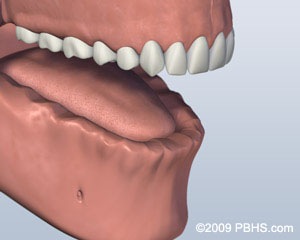
1. Before
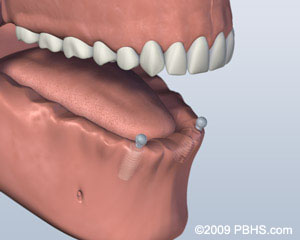
2. Implants Placed
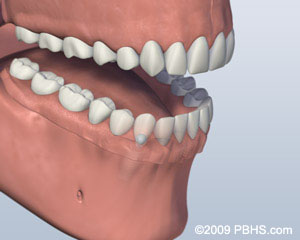
3. Denture Attached
Bar Attachment Denture
Another option involves placing four to six implants, depending on your jaw size or shape, into your lower jaw. After healing is complete, the implants are connected with a custom-made support bar. Your denture will be made with special internal retention clips that attach onto the support bar, enabling the denture to snap firmly into place. This is called an “overdenture.” The advantage of this option is that it is much more stable than the first option and allows very little denture movement. Your denture is still removable for easy cleaning and maintenance.
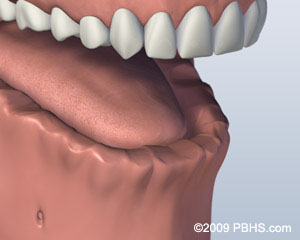
1. Before
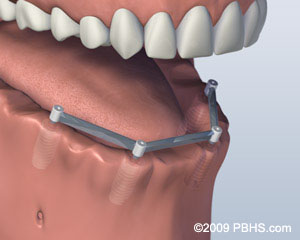
2. Implants Placed
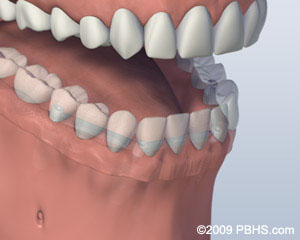
3. Denture Attached
Screw Retained Denture
A third option involves placing five or more implants in your jaw and attaching a permanent denture. Your denture is held in place by screws or clasps that secure it to the support posts or bar. It doesn’t touch the gum tissue, which allows you to clean under the denture without removing it. This denture will replace all your missing lower teeth and will not be removed except at maintenance visits. Although cleaning under your denture without removing it is more time consuming and requires more dexterity, many patients who want a permanent denture prefer this option.
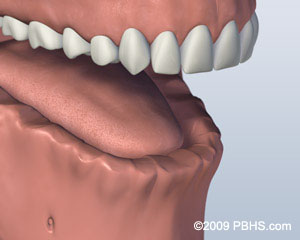
1. Before
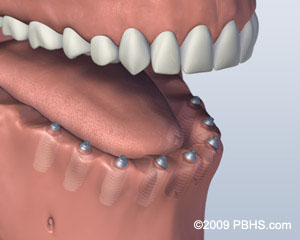
2. Implants Placed

3. Denture Attached
Individual Implants
The final option is to have all your teeth individually replaced so that they will appear to be growing out of your gum tissue and will most closely resemble the appearance of your natural teeth. This option usually requires eight or more implants. Separate abutments or support posts for each one of these implants will be made and crowns for each missing tooth will be placed. The teeth are often joined together for sinus grafting to replace bone height strength and support. Overall, this is the most costly option, because it requires the most implants and individual replacement tooth fabrication. Your replacement options may also be limited by the current size and shape of your jawbone.
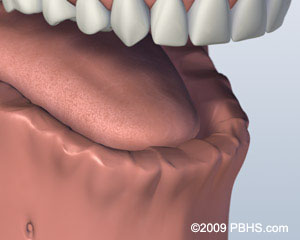
1. Before
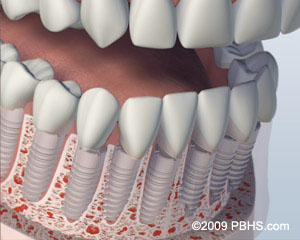
2. Implants Placed
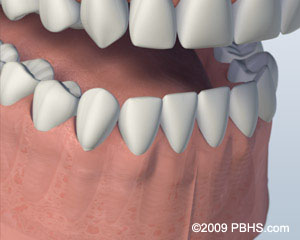
3. Denture Attached
What If I’m Missing All Of My Upper Teeth?
A similar range of treatment options is also available for your upper jaw. However, because the bone is not as hard as that in the lower jaw, people often need more implants to support their new replacement teeth. Depending upon the number of implants to be placed, it may be possible to eliminate the need for covering the roof of your mouth with a complete denture. This option allows you to fully taste your food and gives you a better sense of its temperature. Your denture will feel more natural. You will still have a removable denture, which makes cleaning the support bar and denture much easier.
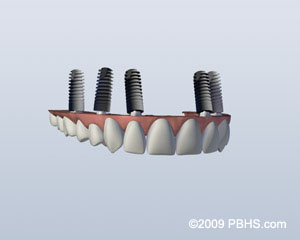
Implant Retained Upper Denture
Depending upon the number of implants to be placed, it may be possible to eliminate the need for covering the roof of your mouth with a complete denture. This option allows you to fully taste your food and gives you a better sense of its temperature. Your denture will feel more natural. You will still have a removable denture, which makes cleaning the support bar and denture much easier.
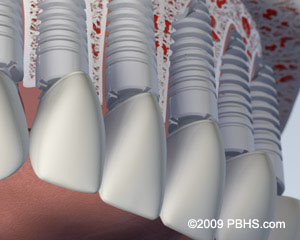
Individual Upper Implants
If you want a restoration that is similar to your natural teeth and therefore not removable, you probably will need eight to ten individual implants placed. This is followed after healing by the placement of the abutments and new replacement crowns.
Our Locations
Please call our practice to schedule your consultation or click here to email us.

- 2975 Westchester Ave
- Suite G02
- Purchase, NY 10577
- (914) 902-5780
- 1177 Summer Street
- 4th Floor
- Stamford, CT 06905
- (203) 614-8355
© Westchester Oral & Maxillofacial Surgery & Implantology. All Rights Reserved. | Accessibility Policy | Privacy Policy
Last Updated: August 1st, 2024 05:46 PM

